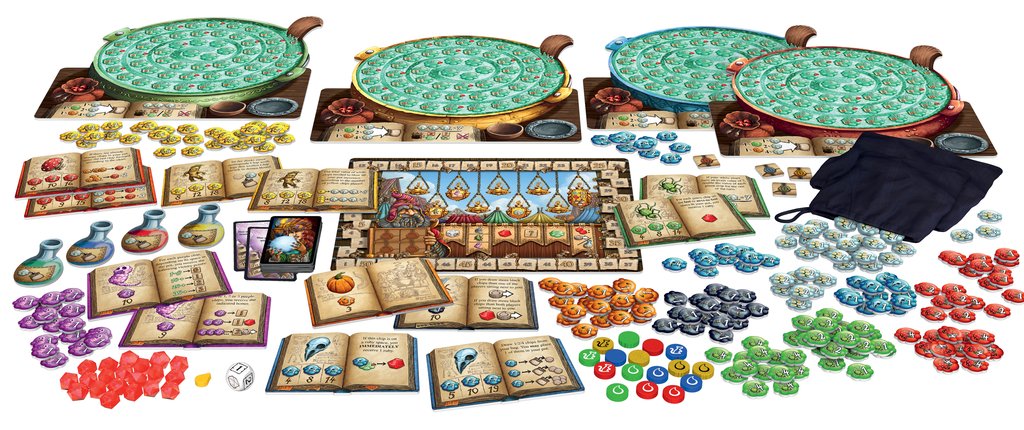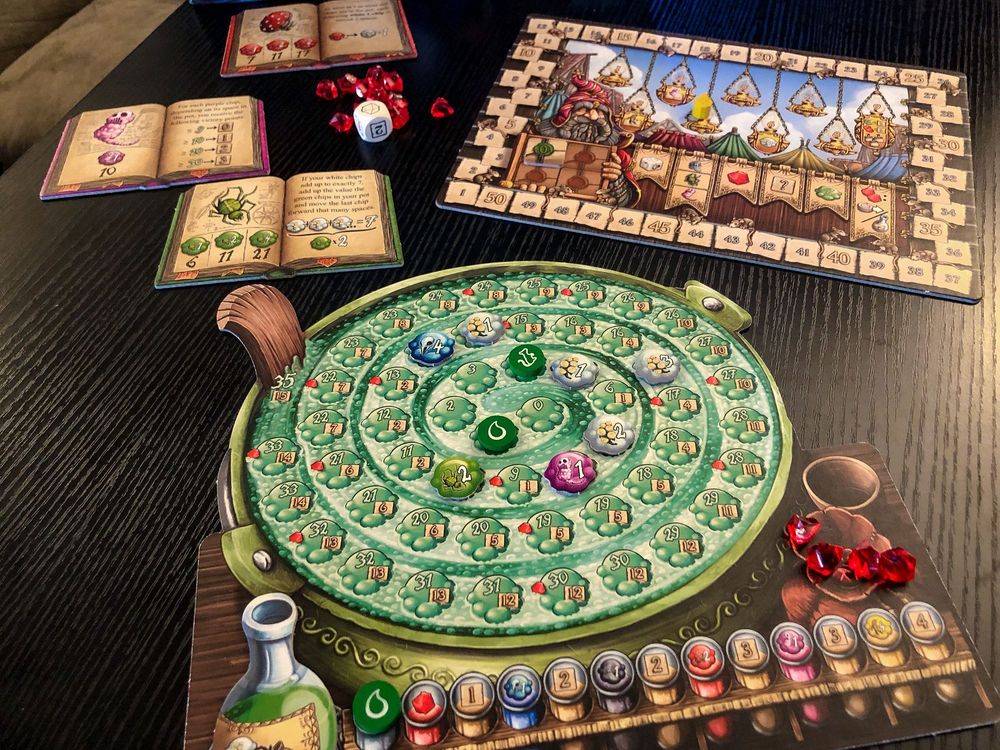In the crazy realm of The Quacks of Quedlinburg, where potions bubble, cauldrons explode, and quacks are in high demand, I found myself donning a crooked hat and stirring up the most calamitous concoctions ever witnessed by human (or quack) eyes.
As I desperately tried to blend bizarre ingredients like “Dragon Snot” and “Bubbling Bumbleberries” into a potion that didn’t turn my cauldron into a steaming volcano of chaos, the loud laughter of fellow quacks echoed through our table.
The Quacks of Quedlinburg is a side-splitting potion-brewing race where victory may go to the quackiest, but in the end, it’s the riotous laughter and outrageous stories that bubble up like the craziest of elixirs.
What’s included in The Quacks of Quedlinburg

- Game Board: The board has tracks for scoring points, indicating the rounds, and displaying the special abilities of certain ingredients.
- Round and Scoring Tokens: Used to keep track of the round number and score.
- Ingredient Books: Each player has a book that shows the values and special abilities of the ingredients.
- Potion Tiles: These tiles represent the different potions you can create.
- Ingredient Chips: Small circular tokens with values from 1 to 4 and special abilities.
- Rubies: A currency used to buy new ingredients and advance your droplet on the scoring track.
- Cauldron Boards: Individual player boards that represent your cauldron and have spaces for ingredients and your scoring track.
How to play The Quacks of Quedlinburg

In this game, players simultaneously draw ingredient chips from their individual pouches and add them to their cauldrons. The goal is to create powerful potions and score points. Here’s a detailed guide on how to play:
Setup
- Place the game board in the center of the table.
- Give each player a cauldron board, ingredient book, and a flask (round token).
- Shuffle the potion tiles and reveal as many as there are players, placing them face up.
- Place the scoring tokens on the starting space of the scoring track.
- Each player receives one white (1) ingredient chip.
- Shuffle the ingredient chips and draw a certain number (based on the round) for each player’s pouch.
- Give each player three rubies.
Rules for The Quacks of Quedlinburg
The Quacks of Quedlinburg is played over a series of rounds, each comprising several phases:
1. Ingredient Draw Phase:
- Simultaneously, all players draw ingredient chips from their pouches and place them face-down into their cauldrons. You continue drawing until you decide to stop or your cauldron explodes (sum of chips exceeds 7).
2. Scoring Phase:
- Determine how far your droplet advances on the scoring track based on the value of the last chip you placed.
- Score points according to your droplet’s position on the scoring track.
- Reveal the next potion tile and award points if you meet its conditions.
3. Buy Phase (Optional):
- Spend rubies to purchase new ingredients and add them to your pouch.
- You can also upgrade your cauldron or buy special abilities.
4. Potion Phase:
- Resolve any special abilities on your ingredient chips or purchased abilities.
- If you have a white (1) chip in your pot, you may start a new round.
Winning the Game: The game is played over a set number of rounds (usually 9). The player with the most points at the end of the game wins.
Special Abilities: Different ingredients have special abilities like gaining extra rubies, ignoring explosion points, or drawing extra ingredient chips.
For the official rules, see the link below:
How to win at the game
The Quacks of Quedlinburg is a game of strategy and luck, where players aim to brew the most valuable potions without their cauldron exploding. Here are some strategies to consider:
- Balancing Risk and Reward: The core of the game is managing risk. Decide how many chips to draw before stopping. Drawing too many chips might cause your cauldron to explode, but drawing too few might limit your potion’s potential. A good rule of thumb is to stop just before you think you might explode.
- Potion Tiles: Keep an eye on the available potion tiles. Try to brew potions that match the ingredients you’re drawing, as they can provide valuable points and abilities. However, don’t be afraid to switch strategies if a more lucrative potion becomes available.
- Special Abilities: Utilize the special abilities of your ingredients to your advantage. Some ingredients can mitigate the risk of explosion, provide additional points, or give you extra rubies. Plan your draws and purchases accordingly.
- Upgrades: Consider investing in upgrades for your cauldron. Upgrades can help you manage risk more effectively, draw additional chips, and gain more rubies. They can be a game-changer in the long run.
- Rubies: Don’t underestimate the importance of rubies. They allow you to buy better ingredients, upgrade your cauldron, and take advantage of special abilities. Acquiring rubies consistently can be a winning strategy.
- Diversify Your Ingredients: Having a variety of ingredient values in your pouch can be beneficial. It reduces the risk of drawing too many high-value chips in a row, which can lead to an explosion. Balance your ingredient mix to manage risk.
- Watch Your Opponents: Pay attention to what potions your opponents are brewing and what ingredients they are purchasing. This can help you adapt your strategy and compete for valuable potion tiles.
- Explosion Management: If your cauldron explodes, it’s not the end of the world. You still gain some points, and you have the opportunity to recalibrate your strategy. Don’t let a single explosion deter you from future success.
- End-of-Game Scoring: Keep in mind that end-of-game scoring can significantly impact the outcome. Some potion tiles and ingredients provide bonus points at the end of the game. Consider how these bonuses might affect your overall strategy.
Remember that luck plays a significant role in the game, and even the best-laid plans can be foiled by a bad draw. Adaptability and a willingness to take calculated risks are key to success in this quacky and entertaining game.